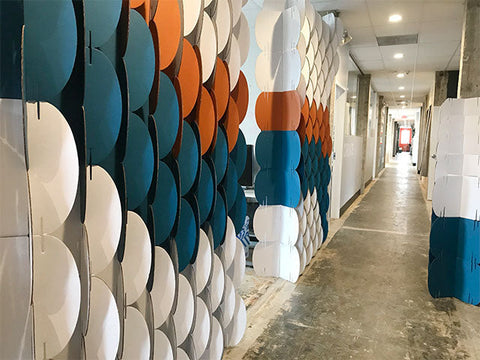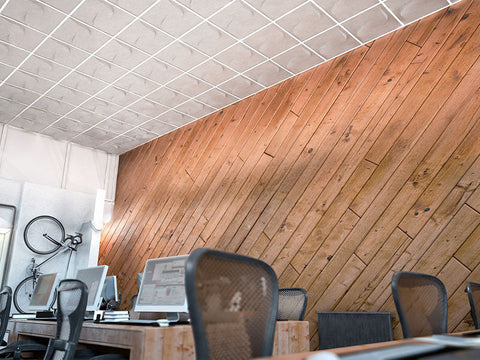Creating dynamic and private learning environments is an ongoing challenge in both educational and professional settings. Whether in classrooms or offices, there's a growing need for flexible solutions that help organize space, support focus, and improve acoustics, without relying on permanent construction. Cardboard room dividers present a lightweight, sustainable option that meets these needs while adapting easily to changing layouts and uses.
At MIO, we believe that materials are only as limited as the imagination shaping them. When we first began developing what would become our Nomad System, it wasn’t with cardboard in mind as the final solution. It was a sketch of an idea—a screen. A boundary. A way to create space where there was none.
To test scale and form quickly, we mocked it up in cardboard. It was easy, familiar, accessible. But when we assembled the full-size prototype, something clicked. It felt sturdy. It looked beautiful. It felt light and effortless. In that moment, we asked the question that would redefine the project: What if we just made it out of cardboard?
That single question flipped our entire approach. We abandoned the traditional materials we were considering and doubled down on paperboard. Because this wasn’t just a temporary stand-in—this was the answer. And in asking a humble material to do more, we unearthed a whole new category of room divider: modular, mono-material, cost-effective, endlessly flexible, and—most importantly—delightfully easy to live with.

Why Choose Eco-Friendly Classroom Dividers? A Long Tradition of Paper Strength
Skeptical about paper or cardboard as structure? You’re in good company—but we invite you to think again. Paper has held architectural reverence for centuries. From the translucent elegance of Japanese shoji screens to the contemplative gravity of Tadao Ando's paper tube pavilions, this "soft" material has a long history of creating profound space.
When engineered correctly, paper is not weak. It’s lightweight yet strong, tactile yet architectural. It invites interaction. It diffuses light. It absorbs sound. And perhaps best of all, it carries a simplicity that feels increasingly rare in a world of complicated solutions.
At MIO Culture, we approached our Nomad System with this lineage in mind. Our cardboard modules are not just panels—they’re part of a structural language. The material is FSC-certified paperboard with up to 70% recycled content, die-cut and designed to interlock for strength and structure. The result? A self-standing, shippable, endlessly reconfigurable screen system that reinvents how we think about walls.

Designed for Real-Life Use: Classrooms and Shared Offices
Nomad isn't a static solution. It's a dynamic tool for space-making. In environments that demand agility—like classrooms and offices—its versatility shines. Here are a few ways educators and professionals are using Nomad:
[products ids=" nomad-system-room-dividers, custom-nomad-room-divider"]
In Classrooms:
-
Reading Nooks & Quiet Zones: Use modules to carve out sensory-friendly areas where students can decompress, read, or work independently.
-
Learning Stations: Divide rooms into distinct subject zones—science, art, language—without heavy construction.
-
Test-Taking Booths: Create privacy partitions for exams or virtual learning setups.
-
Pop-Up Libraries: Define a classroom corner and transform it into a curated, cozy book retreat.

In Offices:
- Huddle Rooms: Build impromptu meeting spaces within open-plan offices without altering infrastructure.
- Desk Partitions: Offer visual privacy in benching systems or shared desks.
- Temporary Work Pods: Provide pop-up individual focus zones for deep work.
- Hybrid Work Solutions: Divide home-office spaces or convert communal areas into Zoom-friendly zones.
- Wellness Corners: Hide meditation cushions, lactation areas, or rest nooks in larger shared spaces.

Customizing Your Partitions for Schools: A Guide to Open vs. Closed Assembly
One of the most rewarding aspects of the Nomad System is how it can shift the mood and function of a space simply by how it’s assembled.
-
Open Assembly leaves gaps between modules, letting light and air pass through. It suggests division without complete separation—ideal for collaborative zones or creative studios.
-
Closed Assembly locks modules together edge-to-edge for visual and spatial privacy. Perfect for quiet corners, meetings, or moments where focus and containment are key.
In both modes, the aesthetics remain striking. Nomad becomes part of the design language of the room. A modular sculpture that adapts to context and intention.
Sustainability That Closes the Loop
True to our ethos, Nomad is as sustainable as it is functional. It’s made in the USA from FSC-certified paperboard with up to 70% recycled fiber. Each module is fully recyclable via existing curbside infrastructure.
No composite materials. No glues that complicate recycling. No additional components or materials that must be separated. This is design as a clean loop. Thoughtfully made, easy to use, and easy to let go of when the time comes.
In a category dominated by synthetic panels and disposable plastic, Nomad proves that beauty and responsibility don’t have to compete. It’s sustainable by design. A tool for culture-makers. A screen for now.
Ready to Redefine Your Classroom Space?
Discover how our products can bring sustainable design and agility to your next project. Explore the full collection of room dividers for schools and universities





